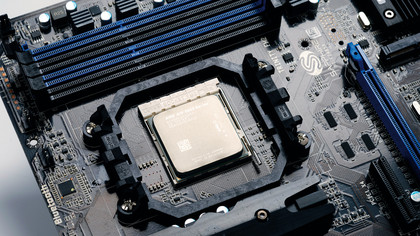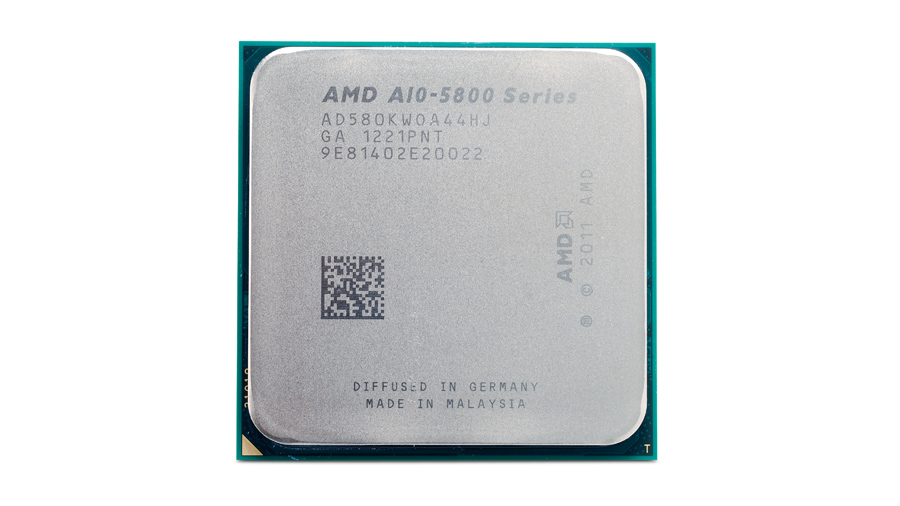TechRadar Verdict
Pros
- +
Decent CPU performance
- +
Some light gaming possible
- +
Interesting chip for media PCs
Cons
- -
Socket restrictions
- -
Gaming performance is ultimately mediocre
Why you can trust TechRadar
Take a CPU. Cram in a graphics core. What d'ya got? If you're AMD, it's a Fusion processor. That sounds futuristic and is indeed the expected shape of things to come for the PC.
More than that, the future is expected to eventually hold nothing but PCs based on system-on-a-chip (SoC) devices. It's already happened to phones and tablets.
But here's the thing. All of Intel's mainstream PC processors are, in fact, already Fusion chips with a fully functioning graphics core. Meanwhile, AMD's current Fusion chips are resolutely designed as low power or low-budget chips. And that even applies to this latest Fusion effort from AMD, the chip formerly known under the Trinity code name, the A10-5800K.
Yes, like previous Fusion chips from AMD, it doesn't even get a proper brand name. It's merely an A Series "Accelerated Processor". That might seem to be a marketing opportunity missed, but who cares? What really matters is the hardware on offer, so let's have a look.
Trinity, of course, is AMD's second Fusion chip for full-power systems; Llano being the first. So, what's changed?
Most obviously, the CPU cores have been upgraded from Stars specification, as seen in AMD's Phenom II, to AMD's brave new Bulldozer architecture. Actually, to be more specific, the cores are actually in Piledriver specification. That's the newly revised version of Bulldozer with the odd nip and tuck, where the same basic modular design remains.
That means modules containing two integer units, but sharing just about everything else including fetch, decode and floating point resources. The idea is to deliver the performance of two cores in die space nearer one core.
Sign up for breaking news, reviews, opinion, top tech deals, and more.
For the first generation of Bulldozer, it wasn't hugely successful by either metric, being both bloated in size and not terribly quick.
Chip geek upgrade

Piledriver isn't a huge change in terms of size, it's still a 32nm chip, but what about performance?
AMD has done a little polishing to improve IPC or the number of instructions crunched per clock. It's pretty low-level stuff and includes more aggressive schedulers, tweaked prefetch and branch prediction and some added vector instructions. The bottom line then is that the changes are chip geek stuff, not a major architectural overhaul.
For that, we'll have to wait until 2013 and Steamroller, which doubles up on the decode engines and might just give Bulldozer a major leg up.
This particular A10-5800K model gets two modules and, therefore, four AMD-style cores. Clock speeds are rated at 3.8GHz base and 4.2GHz Turbo and you get a grand total of 4MB cache. It's pretty similar, therefore, to an AMD FX 4000 chip, just with a bit less cache.
Of course, as a Fusion chip, the CPU cores are just half the story. In many ways, it's the integrated graphics that's most interesting. Despite the Radeon HD 7660D branding AMD is using here, what you get is an architecture based on AMD's previous Radeon HD 6000 series graphics architecture, otherwise known as Northern Islands. So it's a thoroughly modern DirectX 11 design, even if it's not the most advanced on AMD's menu.
In terms of specifics, in the 5800K model you get 384 stream shaders and 24 texture units running at 800MHz. To put that into context, that puts it roughly in between the arse end of the Northern Islands range, which is the HD 6450 and its 160 shaders running at around 700MHz, and the next rung up in the HD 6570 and its 480 shaders at 650MHz. We're not, in other words, looking at a monster gaming GPU. But on paper, this is the fastest integrated graphics core we've seen in a Fusion chip.
To wrap up on a couple of final points of hardware house keeping, there's the matter of socket compatibility. This latest generation of A Series chips get a new socket, known as FM2. Critically, they're not compatible with FM1, which was the socket introduced with the first Llano generation of A Series processors. The new Trinity generation also lacks compatibility with AMD's mainstream sockets, such as AM3.
Benchmarks
Rendering performance
Cinebench 11.5: Index: Higher is better
AMD A10 5800K: 3.16
AMD FX 4170: 3.33
Video encoding performance
x264 3.0 HD: Frames per second: Higher is better
AMD A10 5800K: 20
AMD FX 4170: 20
Gaming performance (with discrete HD 7970)
Metro 2033: Frames per second: Higher is better
AMD A10 5800K: 31
AMD FX 4170: 29
Gaming performance (with discrete HD 7970)
DiRT Showdown: Frames per second: Higher is better
AMD A10 5800K: 31
AMD FX 4170: 29
Gaming performance (integrated graphics)
Just Cause 2: Frames per second: Higher is better
AMD A10 5800K: 29
Intel HD 4000: 14
Gaming performance (integrated graphics)
DiRT Showdown: Frames per second: Higher is better
AMD A10 5800K: 27
Intel HD 4000: 16
With that covered, let's have a gander at performance. The CPU half of this 5800K Trinity chip is the easiest to get a handle of by lining it up directly with some AMD FX Bulldozer chips. Take the AMD FX 4170. It's very close on paper thanks to having the same core and module count.
Yes, it's a little higher clocked at 4.2GHz/4.3GHz Turbo. It has some extra cache that the Trinity architecture lacks. But then it doesn't get Trinity's IPC tweaks.
Game on? And the results? The 5800K is slightly slower in Cinebench and finishes in a dead heat with the FX 4170 in x264 HD video encoding. In other words, the Piledriver update is pretty small fry.
As for overclocking, our testing suggests you shouldn't expect much more than a 500MHz boost. In graphics terms we're less worried about comparisons and more concerned with outright rendering ability. So is the integrated 7660D core good enough for gaming?
In the context of a proper desktop PC, the answer has to be no. Run Metro 2033 at 1,280 x 800 using the global 'high' rather than 'very high' setting and you'll get just 12fps without anti-aliasing. At the other end of the spectrum, use the same resolution for Just Cause 2 at high detail settings but, again, no anti-aliasing and a borderline playable 28 frames per second is possible.
Of course, you can get most games running smoothly if you crush the details aggressively enough, which means this chip is capable of some occasional fun in, for example, a media PC hooked up to an HDTV.
AMD argues that you can hook up a cheap GPU card and run it in CrossFire multi-GPU mode with the integrated HD 7660D - there are scenarios where that just about adds up. But most of the time it's going to make more sense to bag an FX chip and a discrete graphics card.
Technology and cars. Increasingly the twain shall meet. Which is handy, because Jeremy (Twitter) is addicted to both. Long-time tech journalist, former editor of iCar magazine and incumbent car guru for T3 magazine, Jeremy reckons in-car technology is about to go thermonuclear. No, not exploding cars. That would be silly. And dangerous. But rather an explosive period of unprecedented innovation. Enjoy the ride.
